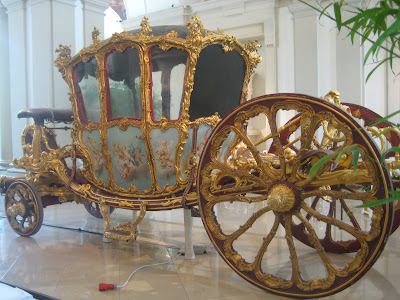 The princely family of Liechtenstein owns one of the greatest art collections in Europe. Parts of it are on display in the Liechtenstein Garden Palace in Vienna, in whose vestibule one may also see one of the best surviving examples of eighteenth century French rococo carriage-making.
The princely family of Liechtenstein owns one of the greatest art collections in Europe. Parts of it are on display in the Liechtenstein Garden Palace in Vienna, in whose vestibule one may also see one of the best surviving examples of eighteenth century French rococo carriage-making. This golden coach, designed by the architect Nicolas Pineau (1684-1754), was made in Paris in 1738 on the orders of Prince Joseph Wenzel of Liechtenstein, who had been appointed the Holy Roman Empire’s ambassador to the court of Louis XV by Emperor Karl VI.
It is a so-called berlin, a new sort of carriage which was developed in the second half of the seventeenth century, and soon gained popularity for use in cities and for ceremonial events. It is 610 centimetres long and weighs 1,400 kilos. The painted decor, possibly by the studio of François Boucher, represents the four seasons.
The Prince of Liechtenstein arrived in Paris in December 1737 and immediately began planning for his official arrival – it says something of the importance accorded to this kind of ceremony that the preparations lasted for an entire year.
The ceremonial entry into Paris eventually took place on 21 December 1738, followed by a public entry to Versailles on the 23rd. The procession was made up of no less than 23 carriages and the Duke of Luynes recorded in his memoirs how he had been impressed by the “extraordinarily rich” carriage of the ambassador.
The new gold coach was however empty on this occasion, as the ambassador, according to the court etiquette, rode in one of the French royal carriages together with the introducer. The gold coach was again seen at Versailles when it was used for Princess Anna Maria’s audience with Queen Marie on 4 May 1739.
Such carriages were mostly sold to local agents when the ambassador’s tenure ended as one generally avoided transporting them over long distances. That Prince Joseph Wenzel took his new carriage with him back to Vienna says something about its quality.
In 1760 Prince Joseph Wenzel used the coach when he went to Parma to act as a proxy for the future Emperor Joseph II at his wedding to Princess Isabella of Parma. It was again used when he escorted the Princess into Vienna the following month. In 1764 he also took it with him to Frankfurt when he acted as Joseph II’s ambassador at the imperial election.
It was first displayed in a museum as a work of art in the twentieth century.





What a splendid and historic vehicle. A few years ago I saw the coach of Catherine the Great at an exhibit of Russian decorative arts here in Toronto. For some reason, a coach is so much more engaging than other artifacts such as a piece of furniture. I found this very interesting.
ReplyDelete